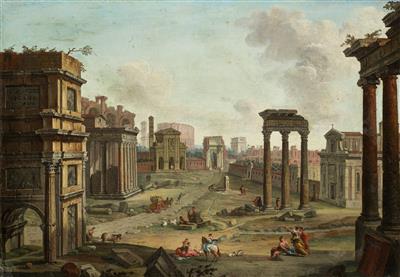Antonio Joli and Workshop

(Modena 1700–1777 Naples)
The Campo Vaccino, Rome,
oil on canvas, 95.5 x 137.5 cm, framed
Provenance:
European Private Collection
The view of the Roman Forum as Campo Vaccino was one of Joli’s favourite themes. The various versions of the subject attest to its success amongst Joli’s patrons.
Toledano notes Gian Paolo Panini’s View of the Campo Vaccino from 1735 (Detroit Institute of Art) as a model for the present composition and also mentions an older View of the Campo Vaccino, dating from the 17th century, by Herman van Swanevelt (Fitzwilliam Museum, Cambridge; see R. Toledano, Antonio Joli – Modena 1700–1777 Napoli, Turin, 2006). The present composition, in which an elegant carriage seems to interrupt the scene’s bucolic tranquility, exhibits a theatricality achieved through perspectival foreshortening and expansion employed by the artist.
Between the 16th century and 1873, the Roman Forum was known as Campo Vaccino, where peasants took their cattle to graze and offered their produce for sale. After the collapse of the Roman Empire, the Roman Forum had fallen into disrepair, with most of its monuments destroyed, as it was used as a quarry for new buildings, such as St. Peter’s Basilica. A growing interest in antiquity during the Renaissance brought the Roman Forum back to importance, and in the late 18th century the first excavations took place.
From left to right appear parts of the Arch of Septimius Severus, the frontal porch of the Temple of Antoninus and Faustina, which was later transformed into the church of San Lorenzo, and the upper section of the Basilica of Maxentius. In the background is the church of Santa Maria Nuova, also called Santa Francesca Romana, above which rises the Colosseum, as well as the Arch of Titus and the Farnese Gardens. Beyond them, the church of Santa Maria Liberatrice, demolished in 1873, and the three columns of the Temple of Castor and Pollux appear. On the far right one can still discern parts of the Temple of Saturn.
We are grateful to Ralph Toledano for confirming the present painting as a work by Antonio Joli and his Workshop on the basis of a high resolution digital photograph.
21.04.2015 - 18:00
- Realized price: **
-
EUR 50,000.-
- Estimate:
-
EUR 40,000.- to EUR 60,000.-
Antonio Joli and Workshop
(Modena 1700–1777 Naples)
The Campo Vaccino, Rome,
oil on canvas, 95.5 x 137.5 cm, framed
Provenance:
European Private Collection
The view of the Roman Forum as Campo Vaccino was one of Joli’s favourite themes. The various versions of the subject attest to its success amongst Joli’s patrons.
Toledano notes Gian Paolo Panini’s View of the Campo Vaccino from 1735 (Detroit Institute of Art) as a model for the present composition and also mentions an older View of the Campo Vaccino, dating from the 17th century, by Herman van Swanevelt (Fitzwilliam Museum, Cambridge; see R. Toledano, Antonio Joli – Modena 1700–1777 Napoli, Turin, 2006). The present composition, in which an elegant carriage seems to interrupt the scene’s bucolic tranquility, exhibits a theatricality achieved through perspectival foreshortening and expansion employed by the artist.
Between the 16th century and 1873, the Roman Forum was known as Campo Vaccino, where peasants took their cattle to graze and offered their produce for sale. After the collapse of the Roman Empire, the Roman Forum had fallen into disrepair, with most of its monuments destroyed, as it was used as a quarry for new buildings, such as St. Peter’s Basilica. A growing interest in antiquity during the Renaissance brought the Roman Forum back to importance, and in the late 18th century the first excavations took place.
From left to right appear parts of the Arch of Septimius Severus, the frontal porch of the Temple of Antoninus and Faustina, which was later transformed into the church of San Lorenzo, and the upper section of the Basilica of Maxentius. In the background is the church of Santa Maria Nuova, also called Santa Francesca Romana, above which rises the Colosseum, as well as the Arch of Titus and the Farnese Gardens. Beyond them, the church of Santa Maria Liberatrice, demolished in 1873, and the three columns of the Temple of Castor and Pollux appear. On the far right one can still discern parts of the Temple of Saturn.
We are grateful to Ralph Toledano for confirming the present painting as a work by Antonio Joli and his Workshop on the basis of a high resolution digital photograph.
|
Buyers hotline
Mon.-Fri.: 10.00am - 5.00pm
old.masters@dorotheum.at +43 1 515 60 403 |
| Auction: | Old Master Paintings |
| Auction type: | Saleroom auction |
| Date: | 21.04.2015 - 18:00 |
| Location: | Vienna | Palais Dorotheum |
| Exhibition: | 11.04. - 21.04.2015 |
** Purchase price incl. buyer's premium and VAT
It is not possible to turn in online buying orders anymore. The auction is in preparation or has been executed already.
